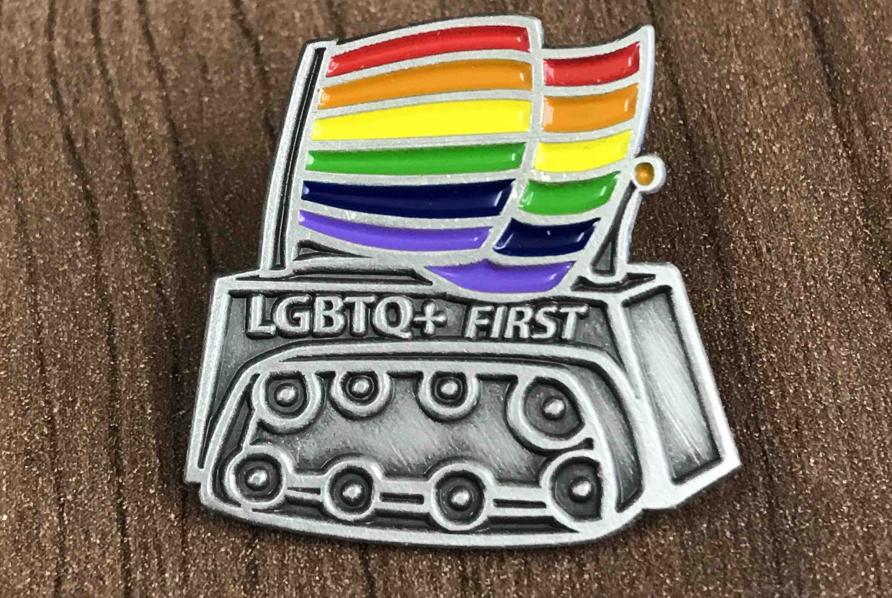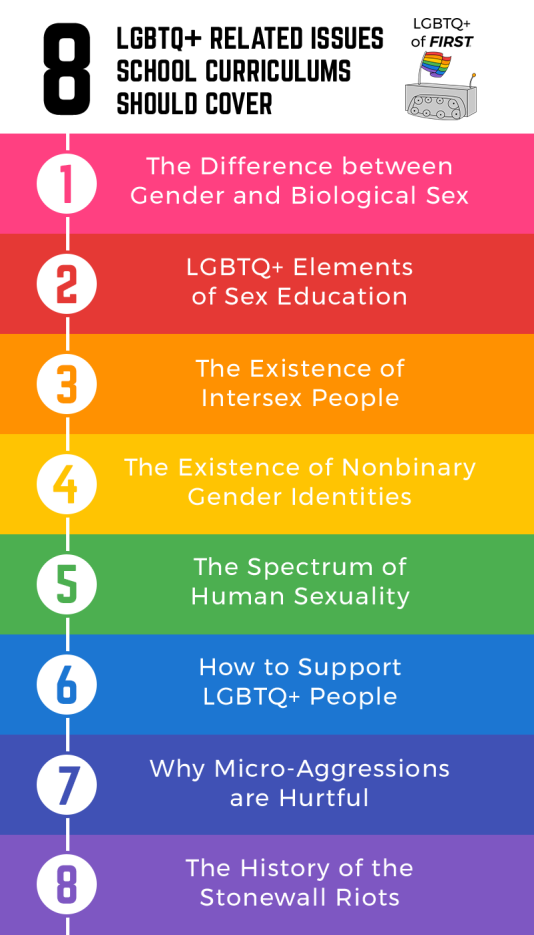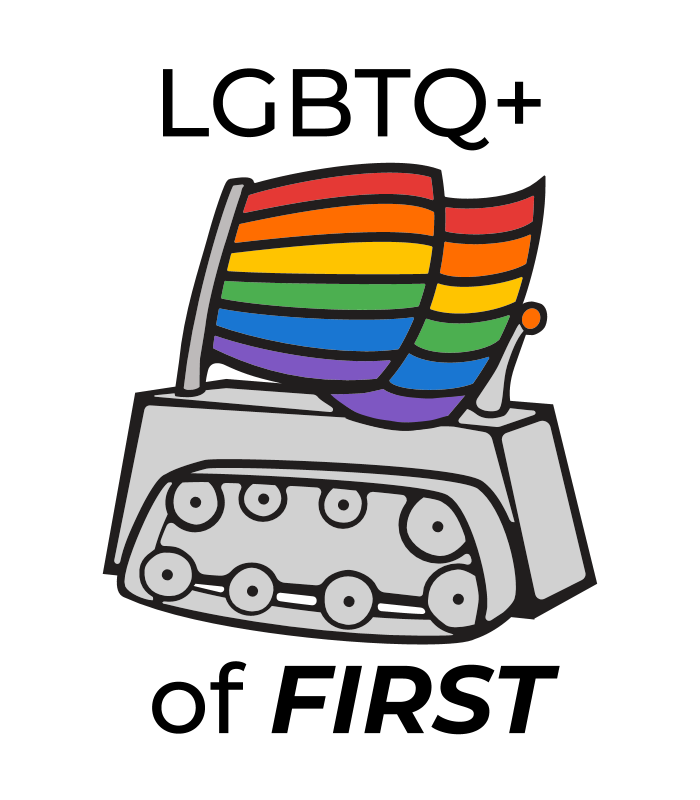|
Remember those awesome LGBTQ+ of FIRST pins we shared at competitions last year? We loved handing them out and promoting our organization throughout the United States and the world. This year, we’re excited to expand our reach and introduce more FIRST-ers to our goal – but we can’t do it without your help.
Please help us by donating to the LGBTQ+ of FIRST Lapel Pin GoFundMe, created by Jon Kentfield, an avid supporter of our mission. In his own words, Jon describes why he supports our mission: “In 2016 a few of the LGBTQ+ members of our community came forward to create a blog and a safe place for people in the community to get advice, and learn about LGBTQ+ issues and how they can have an effect on FIRST teams. While having a conversation with one of these great students last year, we discussed ways that these students can both add some visibility, if they feel safe to do so, and show that they are not alone to students whom may still feel unsafe being out.” Last year, Jon helped us raise over $1,300 to produce 1600 pins – and that was only with two months of fundraising! This year, we hope to create at least 5,000 pins in order to share the positive impact of LGBTQ+ of FIRST with even more breadth, which requires about $3,750. That cost also accounts for the deductions that GoFundMe will make. Any additional funding will go towards more pins, pronoun ribbons, or other LGBTQ+ informational and promotional materials. The goal is to complete creation of the pins by the FIRST Robotics Competition Kickoff at the latest. Thank you for helping to support LGBTQ+ of FIRST, and expanding our reach in the FIRST Community. Our mission is to increase queer visibility in FIRST and the STEM community as a whole by providing resources, both online and offline, to help and educate LGBTQ+ people and their allies. We seek to increase acceptance and tolerance of all peoples and create a community that benefits not only LGBTQ+ people, but everyone, and this is just one way that you can help us do that. Feel free to reach out to us with any questions at [email protected], lgbtqoffirst.org, or any of our other social media! Few words carry as much power as the words we use to describe ourselves. Finding a label that fits your experiences lends a sense of completeness, of accomplishment; it allows you to join a community of others who describe themselves the same way. Many of these words, however, carry more meaning than just a definition.
The word “queer” and its use in the LGBTQ+ community have been a point of contention for much of our history. Today, though many agree that the efforts to publicize LGBTQ+ issues and the concurrent strive for equality has led to the reclamation of the word, it is still often seen – and used – as a slur. To understand this debate, and to informedly take a side, it is important to first understand its history. The origins of the word “queer” have, to a degree, been lost to history. It may have come from a Scottish or German word meaning ‘oblique’ or ‘off-center’, but linguists are uncertain. In any case, by the early 1800s, it had garnered a strongly negative connotation in English – to queer meant to spoil or ruin a situation. The first recorded use of “queer” as a homophobic slur was in 1894, by John Sholto Douglas, 9th Marquess of Queensberry, who blamed the death of his son Francis on Francis’s suspected love interest, Lord Rosebery. Queensberry, in a letter to another son, speculated that “snob queers like Rosebery” had corrupted his son and led to his demise. During the 1900s, people both inside and outside of the community tended to use “queer” pejoratively, with the slur gaining popularity in the 1950s and later. In 1970, linguist Julia Penelope wrote for the journal American Speech that, in her interviews with gays and lesbians, they all felt that the term “was only used by heterosexuals to express their disdain for homosexuals”. As it is today, bullying of LGBTQ+ students was a massively pervasive issue, and many older members of the community today dislike the word “queer” because they most often heard it as a targeted attack on their identity. Some LGBTQ+ activists did embrace the term as a self-identifier: Gertrude Stein, in her 1903 coming-out story Q.E.D., referred to two female love interests as queer. Still, the term remained hateful in mainstream culture until the latter half of the century. The reclamation of the term “queer” trailed after the rise of the mainstream gay rights movement. The term “queercore” emerged in the 80s, sparked by punk zine J.D.s. The publication was launched in 1985 to give a voice to the unruly, anti-establishment wing of the gay rights movement. As cofounder Bruce LaBruce explained, “Gay assimilation was already starting back then, accelerated by the AIDS crisis, so the gay movement was already distancing and disassociating itself from its more unruly, extreme and anti-establishment elements – queers who did not fit into the gay white bourgeois patriarchy.” Queercore music gave voice to LGBTQ+ artists who were tired of societal disapproval, and allowed them to express their outrage through the time-honored outlet of punk music. More radical efforts to reclaim “queer” began in the 1990s. Queer Nation, founded in 1990, is a New York-based LGBTQ+ activist organization. Founded by members of ACT UP (AIDS Coalition to Unleash Power) who were outraged about the escalation of violence against a community still grieving and suffering from the AIDS epidemic, Queer Nation strove to educate the public and protest for the promotion of gay rights. They popularized the chant “We’re here! We’re Queer! Get used to it!”, which became a rallying cry for the community. They also distributed leaflets with titles like “We’re here, we’re queer, and we’d like to say hello!” and “Queers read this – The Queer Nation Manifesto”, spreading information and safe-sex tips, as well as urging LGBTQ+ people to fight for their rights. Their manifesto actively pushed for use of the word “queer” to describe themselves: “Well, yes, ‘gay’ is great. It has its place. But when a lot of lesbians and gay men wake up in the morning we feel angry and disgusted, not gay. So we’ve chosen to call ourselves queer”. Today, “queer” is often used as a catchall term for members of the LGBTQ+ community. For people whose sexuality or gender identity is uncertain or difficult to explain, “queer” is also valued as a concise way to explain how they identify. Still, the word’s history casts a shadow over its use today: on its website, PFLAG advises that, due to its history as a slur, the word “queer” “should only be used when self-identifying or quoting someone who self-identifies as queer”. -- For many LGBTQ+ students, their FIRST team feels like a safe place to come out. The sense of camaraderie, of family, lets them comfortably be who they are and express their identity. Coming out is an extremely important event in the lives of many LGBTQ+ people, and finding a label that describes one’s identity carries just as much weight. On FIRST teams, surrounded by young people who have, for the most part, seen “queer” as a fairly mainstream identifier of sexuality, some may find solace in a label that cements their place in the LGBTQ+ community, but doesn’t hold them to strict standards or stereotypes, and accepts uncertainty or vagueness about the precise nature of their identity. Still, the word’s history cannot be ignored. When I was younger, my dad gave me one of the most valuable pieces of advice I’ve ever received. “Words are just words,” he said, “until you give them meaning.” Though the word “queer” has a controversial history, its meaning today is, simply put, what you make of it. For some, it’s a word we use to describe our identities. For others, it’s a curse spat with hatred and ignorance. Personally, I believe that my queer brothers and sisters have spent decades fighting for our right to describe ourselves however we like, to truly embrace what makes us unique, to take our places in a community that understands not only our struggles, but also our joy, our passion, and our love. I am queer, and I’m proud to say it. But it’s up to you. -Tess M. There’s lots of discussion surrounding the use of labels, especially in the aro and ace communities. This is my experience and opinion on how they are best applied. I use the split attraction model, which divides attraction into sexual and romantic.
My first step on the road to realizing I’m aro/ace (aromantic/asexual) was accepting my asexuality, although I still thought I was heteroromantic. This immediately required an acceptance of the split attraction model that I still believe in. Later on, I started to reconsider my “crushes” and found that they had different circumstances than most people’s. This led me to look further into the various descriptors of romantic attraction. While I didn’t try each of these, the list includes things like fray-, akoi-, quoi-, demi-, and autochoris-. The list goes on and on. Some might call these silly, splitting hairs, or an attempt to be a special snowflake. I ended up using aro/ace, a more accepted one. But I don’t think I would’ve gotten there as soon without looking into these labels. They helped me see that there’s more ways to experience attraction than whatever your friends feel or what the media shows you. Labels in general are descriptions of an experience, not the other way around. Each person’s experiences are unique and likely aren’t shared exactly by anyone else. In my opinion this means labels are only useful to figure out what you are experiencing if they lead you to find resources. They are not rules on how you are supposed to feel. For example, I’ve tried dating since figuring out my current set of labels because I wanted to be close to someone, who happened to have a crush on me. It didn’t work out because of my orientation, but it was definitely worth the try, and I would have missed out on it if I had stuck to my labels. However, labels are very helpful to find a network. Sometimes you need support, advice, or just a person to talk to who understands what you mean. It’s a lot easier to say the closest approximation to what you feel rather than describing it every time. When it comes to interactions, labels should only be used to self-describe. It’s good to understand yourself, but nobody else should try to dictate how you identify yourself. They only need to know how you feel about them. To the aforementioned person, I told her I’m aro/ace, but when we talked about our relationship, I never used a label. It’s important to be honest and leave nothing out when doing this, but it leads to better relationships than simply using someone else’s experiences to describe yourself. Whatever labels you choose to use, remember that who you are is more important than what you are. You love who you love how you love, and how you describe that is entirely up to you. – Cate S.
So, first, an introduction. My name’s Tom – I’m an FRC alum of team 487, the Robo Spartans out of Erdenheim, PA. The team hasn’t existed in that form in many years.
I’m Bi, and use he/him pronouns. I currently mentor FTC team 9618, the CyberSpartans out of the same town. I’m 31, and started as a FIRST student in 2000. I’ve served in many roles – Volunteer Coordinator, Referee, Judge, and most recently I’ve had the honor of serving as one of the Masters of Ceremony at the St. Louis World Championship for FIRST Tech Challenge. This is my weird, fabulous story of the crossroads of FIRST and LGBT. When I was in high school, I came out to one person, and one person only. I was so scared of myself, of who I’d be, that it wasn’t until after college that I truly accepted my sexuality. In a somewhat cliche passage, I was in a community theater production of RENT, where I came out to my friends. It would still be another few years until I came out to my parents, at the ripe age of 28. I count myself lucky – I live in a very welcoming community, with great parents. But what trapped me most, was myself. The only resolve to that was therapy, and time. One of the things that has kept me involved with FIRST so long is the people, the community. I have long felt that you can truly be yourself at a competition – your weird, quirky, unique self. The self you want to be, but are otherwise afraid to embrace outside the sanctity of a Robotics event. We embrace safety as part of our culture. Who is to say that the safety stops at mechanical tools and protective eyewear? Many fraternal societies operate on the principle of having a sacred, shared space where everyone is safe to reveal their secrets. Our shared space just has a shorter perimeter. Why do I feel so passionate about this movement? For one, anything that gives students an opportunity to take a leadership position is fantastic. That’s the whole point of this program – learn skills that you can apply to ANYTHING. Secondly, I have seen far too many people think that they are alone, that nobody in this world can feel the way they do, that there is no place for them past high school. I hope that I can serve as a role model to someone – even just one person, to say that you don’t have to be perfect. You don’t have to get everything right, or even fully know who you are or what you want to be when you grow up. As long as you’re kind to others, celebrate their strengths, and help them through their weaknesses, then this world we share will be a better place. And it’s okay to be open about who you are in our community. I am – and in most of the things I do in FIRST, it doesn’t matter one but. Which is the greatest feeling in the world. -Tom |
About LGBTQ+ of FIRST
LGBTQ+ of FIRST is a student run organization that advocates awareness and acceptance of LGBTQ+ students, mentors, and volunteers of FIRST Robotics. LGBTQ+ of FIRST reaches out to over 1000 members across the FIRST regions and fronts multiple outreach endeavors. Archives
June 2024
Categories
All
|




 RSS Feed
RSS Feed
